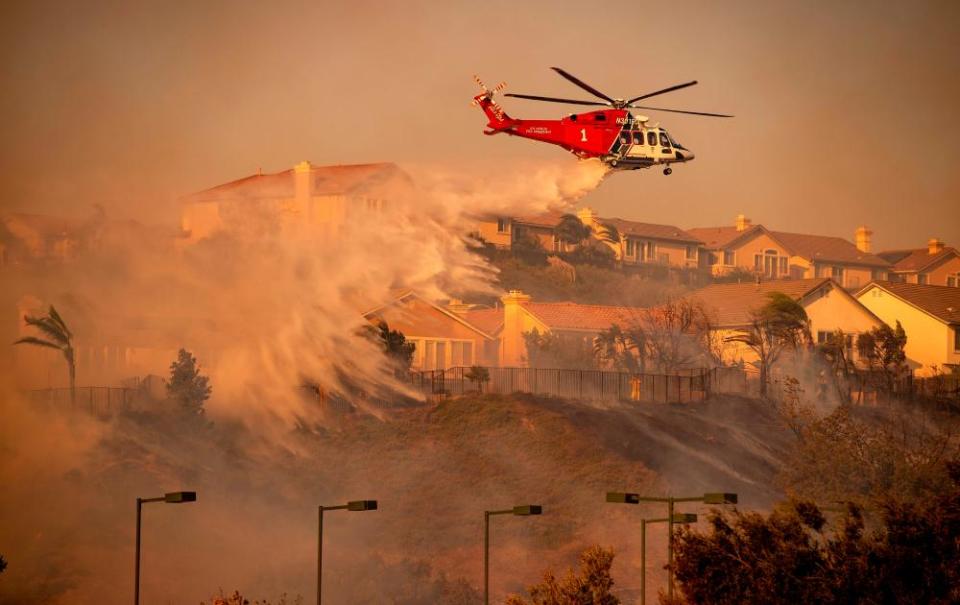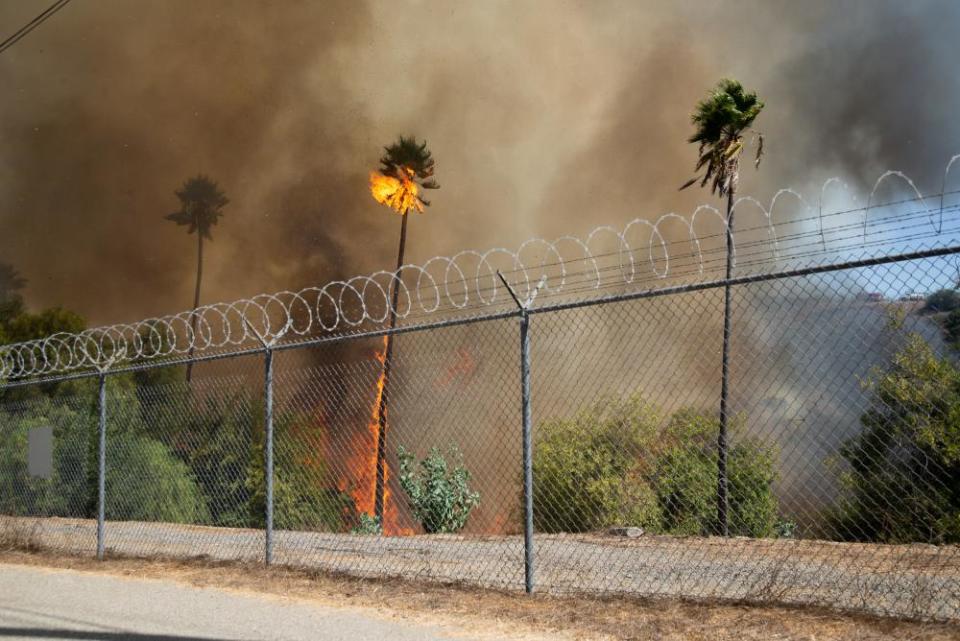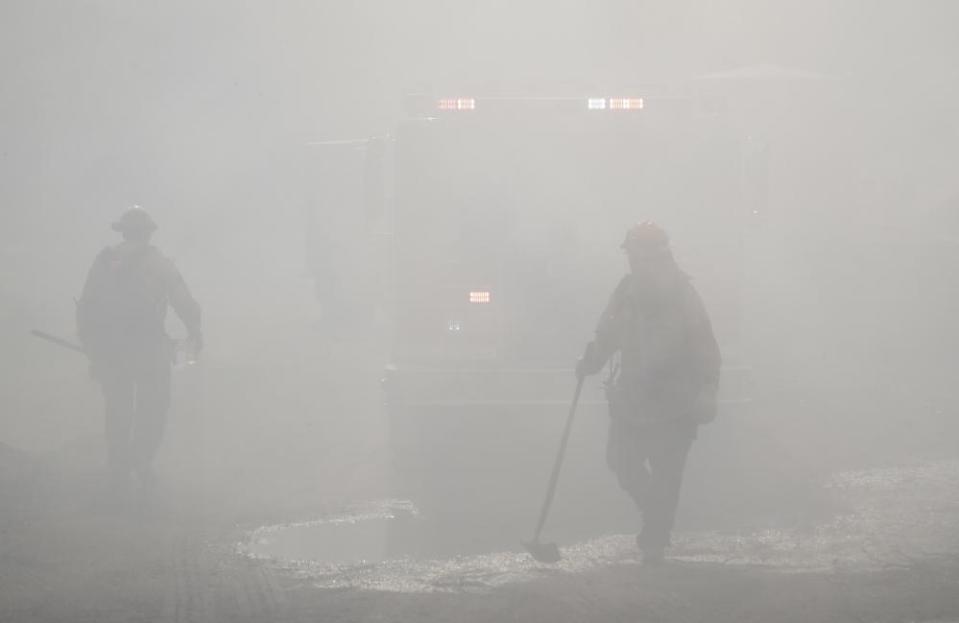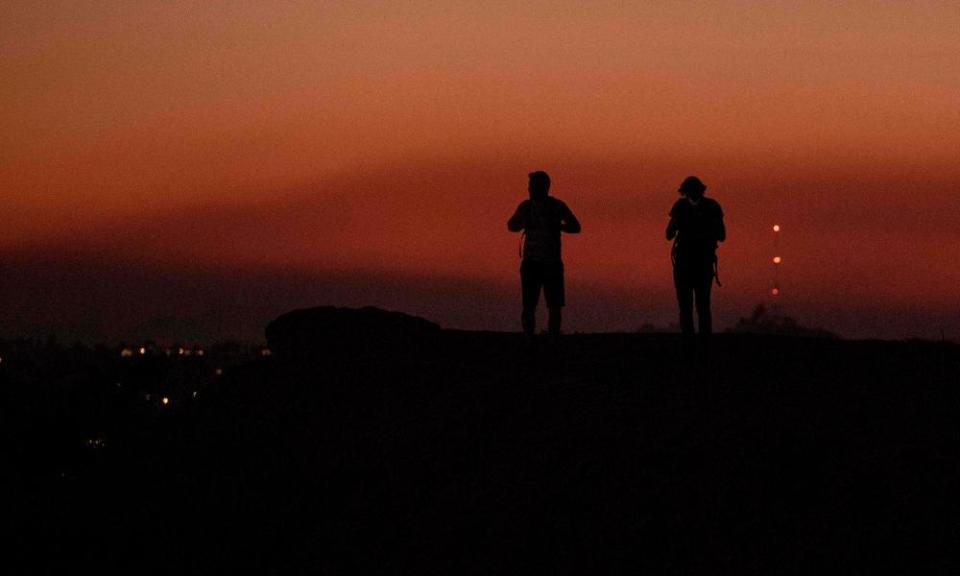A special kind of hell: fires, smoke and heat turn LA into a deadly paradise
The Los Angeles weather forecast has been consistent this week: sunny, hot and potentially deadly.
LA is known around the world as a beachy paradise, with palm trees lining the streets and perpetually pleasant weather. But the climate crisis has increasingly turned some days into a special kind of hell. For the county’s 10 million residents, the month of October, when blistering heat and dangerous winds combine to make the threat of catastrophic fires a daily reality, has become particularly worrisome.
Across southern California this week, residents were coping with what scientists and government officials say is the “new normal” in autumn: debilitating heat, an endless fire season, mandatory mass evacuations and forced power shutdowns to prevent new blazes.
A heatwave this week turned the city of Anaheim, home to Disneyland, into the hottest place in the United States. The Tick fire forced 50,000 people to flee their homes, many in the middle of the night. And with strong winds and temperatures nearing 100F (38C), authorities are bracing for continued fire hazards heading into the weekend. The utility company Southern California Edison proactively shut off power to more than 24,000 customers in five counties on Thursday and could cut power to more over the weekend.

Earlier this month, the Sandalwood fire destroyed a mobile home community 70 miles east of LA, killing an 89-year-old woman. The Saddleridge fire north of the city burned nearly 9,000 acres (3,642 hectares), forced 100,000 people to evacuate, destroyed dozens of homes, and blanketed the city with dirty and dangerous levels of smoke. And a separate brush fire in Pacific Palisades threatened multimillion-dollar homes near the beach.
“My dad has a horrible cough, my mom has eye problems, we all have damage to our respiratory systems,” said Maddhi Jayagoda, whose family survived the Holy fire in southern California last year. The extreme conditions of the past weeks have given the 25-year-old flashbacks to fleeing flames. But her typical remedy to anxiety is often not an option – she can’t go on a run when air is so toxic, it hurts to breathe.
“We don’t have anywhere else we can go,” said Jayagoda, who works at an ad agency in West Hollywood. “I feel like we’re just stuck having to deal with this.”
The hazards are on track to get much worse.
LA has long been notorious as one of the worst cities for pollution, smog, and traffic, though the state as a whole has made progress in recent years in reducing emissions. But the crisis of wildfires, which release large amounts of carbon dioxide into the air, has dramatically derailed that progress.
The Golden State suffered its most destructive year of wildfires in 2018, when more than 1.8m acres (728,400 hectares) burned, 17,000 homes and 700 businesses were destroyed, and more than 100 people died.
“We’re expecting to see more and bigger wildfires if the climate continues in its current path,” said Yifang Zhu, environmental health sciences professor at the University of California, Los Angeles. The climate crisis has created conditions across the American west more favorable for wildfires, including drier and warmer forests.

“Now we can have wildfires anytime of year,” said Ed Avol, clinical medicine professor and air pollution expert at the University of Southern California. “They seem to be longer, more serious and more persistent … This is becoming a regular way of life for us.”
In addition, the expansion of housing in and around high-risk areas in southern California has escalated the risks of fires and put more people potentially in harm’s way.
The long-term health effects of fire exposure are uncertain, Avol said.
But it is clear that this new norm of heat and bad air looks dramatically different for different populations, in a region plagued by extreme income inequality, poverty, and health disparities.
While wealthier neighborhoods and coastal areas tend to enjoy more shade, air conditioning and breezes, inland suburbs regularly overheat and expose lower-income residents to extreme temperatures indoors and outside.

That means October can be especially brutal for those who already suffer significant disadvantages. Rita Dunn, a 39-year-old woman who has been homeless and living outside for about two years, is currently sleeping in a makeshift structure by train tracks in the San Fernando Valley, not far from the Saddleridge fire.
“I wore these goggles, but it’s impossible to do anything, and you can’t get away from it,” she said, recounting the peak of the fire, which sent hot embers in her direction. She put bandanas on her three dogs to try to protect them from the toxins, but she wasn’t sure it made much of a difference. “We just laid there, with ash raining down.”
She didn’t evacuate: “Where would I evacuate to?” This week, she’s dealing with the aftereffects of the toxic air combined with heat nearing 100F (38C).
“I’ve been sitting here for the last three hours with my brain melting,” she said on Tuesday, adding that one of her dogs lays next to her water tank to try to stay cool, while another digs a hole in the dirt. “Every second feels like a million years when you’re having trouble breathing.”
At Skid Row, the epicenter of the region’s homelessness crisis in downtown LA, advocates said the heat was making public health emergencies even worse.
“People are accessing fire hydrants, because there’s not enough water stations available,” said the Rev Andy Bales, CEO of Union Rescue Mission (URM), which runs a shelter at Skid Row. The heat exacerbates hygiene problems for people living in encampments, he said. “We are just leaving too many people too long on the street, and their health is fading.”
Inside the URM, Kat Doherty, who has been homeless for several months, said she didn’t know how people were staying alive in tents: “I try to go quickly from one air-conditioned spot to another. It’s really, really treacherous out there – the dehydration, the sun damage on their skin. And it definitely affects their mental health.”
“You’re breathing in ash. It’s like you’re smoking,” she said.

Gary Williams, a 65-year-old Skid Row resident at the URM, said the heat was making people irritable, distressed and prone to conflict: “It drives you crazy. It does something to your brain.”
When the temperatures get above 90F (32C), Joe Nicchi, who runs a popular ice-cream truck in the region, says his business suffers a noticeable drop. “You would think ice cream does well [in the heat], but people don’t go outside. They go from an air conditioned car to an air conditioned house. We struggle.”
Workers at Disneyland adjust their outfits – removing bowties, vests and other layers – when it gets this hot, said Chris Duarte, president of the union that represents the employees.
For day laborers and domestic workers, many of whom are undocumented and don’t have health insurance, the fires can mean lost work, untreated illness, or hazardous jobs, said Maegan Ortiz, director of a not-for-profit that has assisted immigrant workers affected by the fires. Some workers tend to houses in wealthy neighborhoods after their employers have evacuated, she said: “We hear about these persistent coughs that won’t go away, tightness in the chest, not feeling like you can breathe deeply.”
At Griffith Park, a popular LA destination for Hollywood sign selfies, Tony Garcea said the bad air quality would not stop him from getting exercise: “I almost passed out, but then I found some shade,” he said as he stretched on a park bench. Asked about air pollution, he shrugged: “In ten, 20, 30 years from now, I might have some respiratory infection or disease. Who knows what we are breathing in and out.”
Even with the threat of fires, the 32-year-old said he’d still prefer LA to any other region that gets colder than 50F (10C).
A few miles away on Hollywood Boulevard by the Walk of Fame, Naraji Moral, 27, was sweating in the hot sun on a corner where she and other rappers perform for passersby.
“I feel like the government is fucking with our planet,” she said, standing in 90F (32C) heat. “I’m waiting for fall. This is not fall.”
Aisha Nyo, who works long days at an outdoor T-mobile kiosk on Hollywood Boulevard, gestured to her row of empty water bottles when asked how she was coping with the heat. Next to her, a man ran through a fountain in the plaza, soaking his clothes.
“Certain times you just can’t breathe,” Nyo said, adding, “But I see what’s going on around the world and I try not to complain. It could be worse.”

